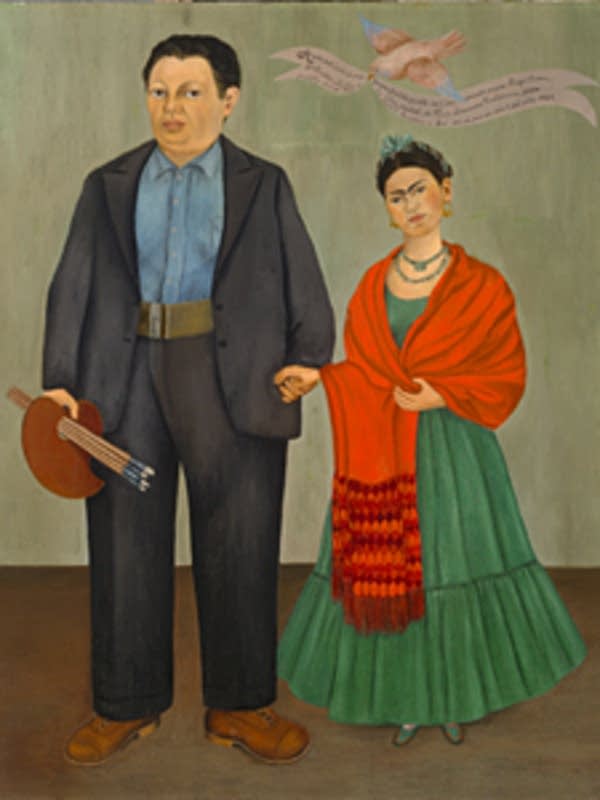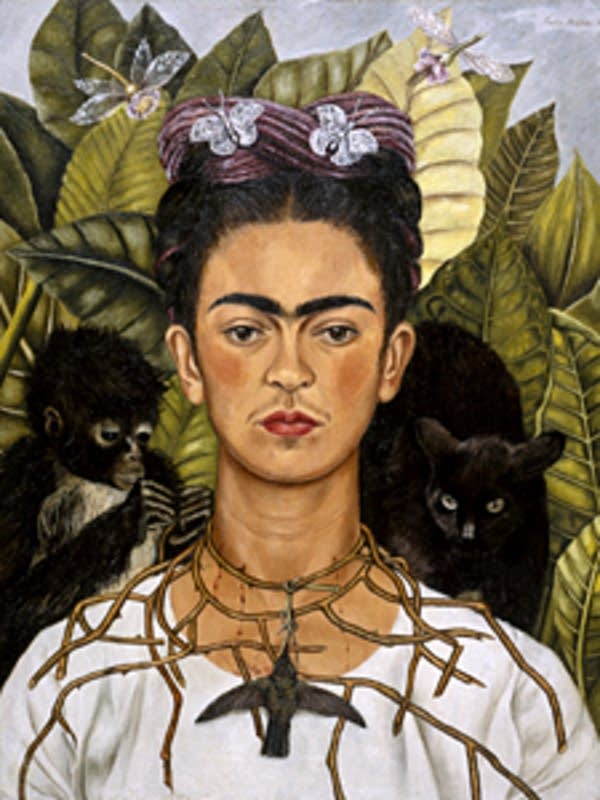Walker Art Center launches major Frida Kahlo Show

It seems like Frida Kahlo's image is almost everywhere. You can find her distinctive eyebrows and piercing stare splashed on everything from magnets, t-shirts to mugs and posters.
But the chance to actually see her paintings is a rare treat.

Kahlo died young, in her forties, and her body of work is relatively small. Institutions and individuals that own her paintings are often reluctant to part with them, even for a few months.
One of the major works in the show, a double self-portrait called "The Two Fridas" has never been shown before in the United States.
Create a More Connected Minnesota
MPR News is your trusted resource for the news you need. With your support, MPR News brings accessible, courageous journalism and authentic conversation to everyone - free of paywalls and barriers. Your gift makes a difference.
Walker Associate Curator Betsy Carpenter says the show is generating an unbelievable amount of buzz. All of the Walker's Kahlo-related events sold out in record time.
"I think people know Kahlo, they know her reputation, they've heard the dramas of her life. It's a fascinating story, it's absolutely sensational and I think the story draws people to her." Carpenter says. "When you walk through the doors of the Walker you're going to see that story, you'll experience it but you'll also be introduced to this amazing world that just unfolds before your eyes."

The idea for the show came in 2003, when staff at the Walker and the San Francisco Museum of Modern Art started talking about featuring an artist whose work can be found in Art History books, but who few have had the opportunity to see in person.
Carpenter says Kahlo was the natural choice.
"We all landed on Frida Kahlo as being this amazing artist who is absolutely crucial to many artists working today, and artists that the Walker has in the collection." Carpenter says. "So people might ask why are you doing a Kahlo show and you don't have a Kahlo work in your collection. She provides that context, she provides that perspective."
Critics hail Kahlo's work for its groundbreaking depiction of the body and personal identity. Many of her paintings are meticulous self-portraits which, as with many of her other images, showing physical suffering.
Born in a Mexico City suburb in 1907, Kahlo became famous as the wife of celebrated Mexican muralist Diego Rivera.

The root of much of her suffering started when she was 18 and the bus she was riding home from school was hit by a trolley. The accident almost killed her. She underwent more than 30 spinal surgeries and never fully recovered. Kahlo's health worsened in the late 1940s and in 1953, surgeons amputated her right leg at the knee.
Her marriage to Rivera was another source of suffering. Rivera was notorious for his infidelity and the two separated more than once. Kahlo had many lovers herself, but her relationship with Rivera was central to her life, and is depicted throughout her work.
Art historian and Kahlo biographer Hayden Herrera guest curated the show. Herrera says themes of emotional and physical suffering are part of what drives the worldwide Frida mania because so many people relate to her story.
"I think everybody in the world suffers and Frida Kahlo did," Herrera says. "Her painting ends up, even though it's very much about all that suffering, it ends up being bigger than all of that suffering. It's not just about her. Somehow, the reason they're so strong is that other people get it and it relates to things that they feel and I think that is probably one of the reasons she is so popular."
A key feature of the Walker show is a collection of 90 personal photographs. This is the first time many have been exhibited.

Organizers say the photos provide a rare glimpse into Kahlo's personal life. There are family portraits, candid snapshots of Diego Rivera and images of Kahlo in traction in the hospital. There are also shots of world figures like Russian revolutionary Leon Trotsky and surrealist painter Andre Breton.
Art dealer Armando Colina owns an art gallery in Mexico City. He has coordinated 51 shows of Kahlo's work since the 1970s and played a major part in organizing the Walker exhibit.
He says shows of Kahlo's work typically attract hundreds of thousands of visitors. But he says it's her work that is really important.
"Her imagery is so unique there is nothing to compare her with in art. I think she brought to art a very unique universe based on her anguish, her loves, her frustrations."
The Walker Art Center show opens Saturday and will be up until January 20th. After that, it travels to Philadelphia and then to San Francisco.
